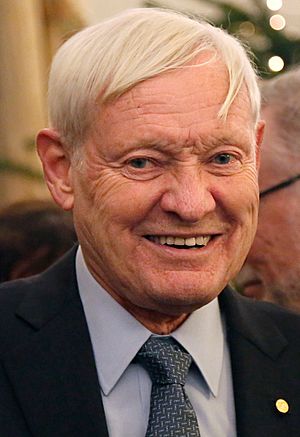Joachim Frank facts for kids
Quick facts for kids
Joachim Frank
|
|
|---|---|

Joachim Frank under Nobel Prize press conference in Stockholm, December 2017
|
|
| Born | September 12, 1940 |
| Citizenship | United States, Germany |
| Education | University of Freiburg (BS) University of Munich (MS) Max Planck Society Technical University of Munich (PhD) Cornell University |
| Known for | Single-particle cryo-electron microscopy Ribosome structure and dynamics |
| Spouse(s) |
Carol Saginaw
(m. 1983) |
| Children | Ze Frank & Mariel Frank |
| Awards |
|
| Scientific career | |
| Fields | Structural biology Cryo-electron microscopy |
| Institutions | University at Albany, Department of Biomedical Sciences Columbia University College of Physicians and Surgeons, Department of Biochemistry and Molecular Biophysics |
| Thesis | Untersuchungen von elektronenmikroskopischen Aufnahmen hoher Auflösung mit Bilddifferenz- und Rekonstruktionsverfahren (1970) |
| Doctoral advisor | Walter Hoppe |
| Other academic advisors | Robert Glaeser, Robert Nathan |
Joachim Frank (German pronunciation: [ˈjoːaxɪm ˈfʁaŋk]) HonFRMS; born September 12, 1940) is a German-American biophysicist at Columbia University and a Nobel laureate. He is regarded as the founder of single-particle cryo-electron microscopy (cryo-EM), for which he shared the Nobel Prize in Chemistry in 2017 with Jacques Dubochet and Richard Henderson. He also made significant contributions to structure and function of the ribosome from bacteria and eukaryotes.
Life and career
Frank was born in Siegen in the borough of Weidenau. After completing his Vordiplom (B.S.) degree in physics at the University of Freiburg (1963) and his Diplom under Walter Rollwagen's mentorship at the Ludwig Maximilian University of Munich with the thesis "Untersuchung der Sekundärelektronen-Emission von Gold am Schmelzpunkt" (Investigation of secondary electron emission of gold at its melting point) (1967), Frank obtained his Ph.D. from the Technical University of Munich for graduate studies in Walter Hoppe's lab at the Max Planck Institut für Eiweiss- und Lederforschung (now Max Planck Institute of Biochemistry) with the dissertation Untersuchungen von elektronenmikroskopischen Aufnahmen hoher Auflösung mit Bilddifferenz- und Rekonstruktionsverfahren (Investigations of high-resolution electron micrographs using image difference and reconstruction methods) (1970). The thesis explores the use of digital image processing and optical diffraction in the analysis of electron micrographs, and alignment of images using the cross-correlation function.
As a Harkness postdoctoral fellow, he had the opportunity to study for two years in the United States: with Robert Nathan at the Jet Propulsion Laboratory, California Institute of Technology; with Robert M. Glaeser at Donner Lab, University of California, Berkeley and with Benjamin M. Siegel at Cornell University, Ithaca, New York. In the fall of 1972 he returned briefly to the Max Planck Institute of Biochemistry in Martinsried as research assistant, working on the theory of partial coherence in electron microscopy, then, in 1973, he joined the Cavendish Laboratory, University of Cambridge as Senior Research Assistant under Vernon Ellis Cosslett.
In 1975 Frank was offered a position of senior research scientist in the Division of Laboratories and Research (now Wadsworth Center), New York State Department of Health, where he started working on single-particle approaches in electron microscopy. In 1985 he was appointed associate and then (1986) full professor at the newly formed Department of Biomedical Sciences of the University at Albany, State University of New York. In 1987 and 1994, he went on sabbaticals in Europe, one to work with Richard Henderson, Laboratory of Molecular Biology Medical Research Council in Cambridge and the other as a Humboldt Research Award winner with Kenneth C. Holmes, Max Planck Institute for Medical Research in Heidelberg. In 1998 Frank was appointed investigator of the Howard Hughes Medical Institute (HHMI). Since 2003 he was also lecturer at Columbia University, and he joined Columbia University in 2008 as professor of Biochemistry and Molecular Biophysics and of biological sciences.
Awards (selection)
- 1994 Humboldt Research Award of the Alexander von Humboldt Foundation
- 2006 Fellow of the American Academy of Arts and Sciences
- 2006 Member of the National Academy of Sciences
- 2014 Benjamin Franklin Medal in Life Science of the Franklin Institute
- 2017 Wiley Prize in Biomedical Sciences
- 2017 Nobel Prize in Chemistry
- 2018 Honorary Doctorate, University of Siegen (Germany)
- 2018 Honorary Fellow of the Royal Microscopical Society
Selected publications
Books
- .
- .
- .
- .
- .
- .
Articles
See also
 In Spanish: Joachim Frank para niños
In Spanish: Joachim Frank para niños

